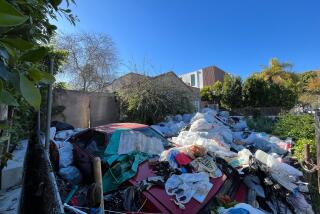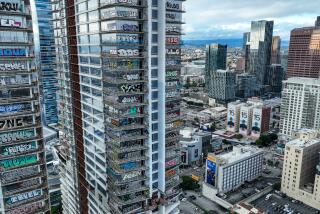Tackling a Fabric Stain of Huge Proportions
Don’t complain to James E. Holland about your soiled carpet or shirt-collar ring. He’s grappled for most of three years with the granddaddy of all fabric stains: grime covering more than four acres, the entire surface of two immense domes on Terminal Island.
The fabric-covered domes were once nearly white. Now, for reasons no one can fully explain, they are the blackened color of a child’s dirty knees.
The Los Angeles Export Terminal shelled out $20 million to build the domes in 1998 and 1999, and has spent virtually all of the time since then in a futile battle to remove the dirt, said Holland, the facility’s vice president of operations.
Consultants have been brought in. Various cleansers have been tried. Holland has scrubbed the walls himself, out beyond the oleander hedges, and has weighed the merits of various protective coatings.
Nothing has come close to working.
“It’s an embarrassment,” he said. “It’s a major frustration.”
Each dome is 140 feet tall, topped by an additional 30-some feet of squarish housings for conveyor equipment. In a landscape otherwise dominated by square lines and angles, the adjoining domes are distinctive features of Los Angeles Harbor, filling your field of vision if you cross the Vincent Thomas Bridge traveling east toward Long Beach.
They were created in response to community outcry and a ruling by the South Coast Air Quality Management District, which decreed that dust-causing petroleum coke -- a byproduct of oil refining used for export -- can no longer be stored in the open air.
The privately operated export terminal collects tons of the black, gravelly substance from nearby refineries and loads it onto ships bound for Japan, Thailand, Europe and the Philippines. The coke, worth upward of $10 a ton on the world market, is burned overseas as a fuel for power plants, cement factories and steel mills.
Domes were seen as the most cost-efficient way to stockpile the material. Each one can store up to 75,000 metric tons of coke until it can be transported to freighters by means of a mile-long, covered conveyor belt.
The domes’ deep charcoal appearance has become a public relations nightmare, however. Even though homeowners fought to put them in place, some critics say the stains symbolize the continuing pollution problem at the harbor.
Diesel fumes, coke dust, oil smoke, tire rubber and other chemicals form a “toxic goulash,” as one activist called it, that invades San Pedro and Wilmington any time the breezes stir.
The AQMD estimates that 34,000 trucks a day roll through the harbor, billowing tons of airborne contaminants. A container ship in port for three days spews as much as an entire day’s output from an oil refinery.
“As long as I don’t inhale, I guess, I’m fine,” said activist Judy Cairns.
Bill Schwab, who moved to Wilmington as a child in 1927, has attended community meetings about dust and air pollution for six years. His wife, Gertrude, a former Los Angeles Harbor commissioner, was one of the more vocal residents until she became ill and died in April, a few months after being diagnosed as having lung cancer.
“Never smoked,” Schwab said. “That’s what’s happening: We’ve got a big epidemic of cancer in this community, and asthma.”
Schwab understands that trucks and ships account for most of the airborne pollution, but he also looks askance at the discolored domes.
“If they’re black -- and they were white -- where’s the black coming from?” Schwab said. “It tells you that they’re leaking. [The coke dust] is in the air. Everybody can see it on the domes.”
Coke dust, though not a carcinogen, is extremely fine and thus a serious health risk, said Carol Coy, an AQMD compliance engineer who helped develop the new storage regulations. Similar types of fine dust have been linked to asthma, respiratory infections and premature death, she said.
But residents are misguided if they criticize the domes, which have accomplished their purpose by eliminating tons of airborne pollution, Coy added.
Very little coke dust now finds its way into the air, Coy said, and it is infinitesimal in quantity compared to the enormous amounts of matter, including carcinogens, that pour out of diesels and ships, making the harbor one of the region’s most dangerous places for cancer risk.
“The domes are the solution,” she said. “They don’t leak. [They] are actually what the community begged for for years.”
Holland said the real mystery is why dirt sticks so tenaciously to the domes while surrounding buildings remain relatively clean. One theory is that the nonporous fabric and foam layer beneath it create a static electrical charge -- like a sock pulled from a dryer.
The domes tend to be darkest where the underlying layers of foam are the thickest. A consultant suggests that the plasticizer used in the foam has been breaking down and migrating to the surface, causing a stickiness that catches airborne grit.
“Frankly,” Holland said, “we haven’t figured it out.”
Domes have the advantage of containing a large amount of material within a small space. Construction involved laying down rings of concrete, attaching fabric to them and inflating the fabric with air. Foam was then sprayed onto the interior. Reinforcing steel bars and concrete were set in place beneath that.
Holland compared it to spraying a swimming pool upside down.
From 100 to 200 covered trucks arrive at the facility every day, dumping more than 20 tons per trip. The coke forms mountainous piles inside the domes, a nearly black landscape despite powerful ceiling lights.
Bulldozers climb a steep ramp to enter the domes, moving the coke into funnel-like “draw-downs” that feed the conveyor system. The coke finally gushes out at a rate of nearly 5,000 tons an hour into the holds of cargo ships.
Working in the domes is surreal, dozer operators say. Steam rises from the piles. Machinery vibrates. In the blackness, the walls seem to close in.
“You’ve got to have your mind on your work,” said veteran Jim Callazzo, 73.
Although some see the domes as an interesting landmark on Terminal Island, operators of the export terminal cast their own vote when they opened a third, 75,000-ton coke storage structure earlier this year.
Avoiding the chance to extend a line of domes across the harbor landscape, they opted for the most boring design they could come up with: a building known as The Shed.
But it’s as clean as a starched shirt.
To see video online, go to www.latimes.com/surround ings.
More to Read
Sign up for Essential California
The most important California stories and recommendations in your inbox every morning.
You may occasionally receive promotional content from the Los Angeles Times.










